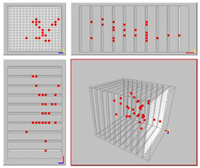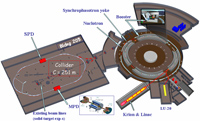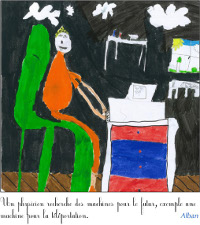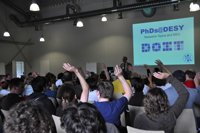 |
|
|
 |
What will happen after the DBD

Test beam studies like these for detector prototypes are an important factor for the DBD. |
Right now, the two detector groups are striving to update their detector concepts towards the detailed baseline design (DBD) aimed to be completed in 2012. This includes many activities such as component R&D, integration of the components of detectors and further into the accelerator, and the simulation of performance. I have described that resources are indispensable for these efforts and made requests for support. There is another important point, which has a significant effect to the incentive of the groups to conduct the programme. Detector groups often raise the question of what will happen to the DBDs when they are completed. The question reflects another one, namely how the ILC project will proceed after the present TDR phase. These are questions that inquire about the prospect of the future programme for ILC exceeding my given mandate. Nevertheless I am also very much concerned about them since they strongly affect the morale of the community. It is quite natural for the detector groups to hope that when DBDs are ready to present a good physics case for ILC, they will become useful for the programme to realise the ILC. And this hope gives incentive to them to work hard under the difficult environment. I had the impression the recent meeting of the International Linear Collider Steering Committee (ILCSC) could strengthen such incentive.
Read more...
-- Sakue Yamada
Research Director's Report Archive |
 |
|
|
 |
| Upcoming meetings, conferences, workshops
First Baseline Assessment Workshop
KEK, Tsukuba, Japan
7-10 September 2010
XXV Linear Accelerator Conference (LINAC10)
Tsukuba, Japan
12-17 September 2010
Topical Workshop on Electronics for Particle Physics (TWEPP-10)
Aachen, Germany
20-24 September 2010
Symposium on the Superconducting Science and Technology of Ingot Niobium
Jefferson Lab, Newport News, USA
22-24 September 2010
1st International Workshop on Accelerator-Driven Sub-Critical Systems & Thorium Utilization
Virginia Tech, Blacksburg, Virginia, USA
27-29 September 2010
19th International Spin Physics Symposium (SPIN 2010)
Jülich, Germany
27 September - 2 October 2010
EUDET Annual Meeting 2010
DESY, Hamburg, Germany
29 September - 1 October 2010
Upcoming schools
Fifth CERN-Fermilab Hadron Collider Physics Summer School
Fermilab, Batavia, IL, USA
16-27 August 2010
Fifth International Accelerator School for Linear Colliders
Villars-sur-Ollon, Switzerland
25 October - 5 November 2010
|
|
|
GDE Meetings calendar
View complete ILC calendar
|
|
|
 |
 |
|
|
 |
Introducing: ILC NewsLine mini series on the future

Future ions: a schematic view of NICA, the Nuclotron-based Ion Collider fAcility at the Joint Institute for Nuclear Research in Dubna, one of many possible future projects. |
This week marks the beginning of a small series in ILC NewsLine on future projects in particle physics beyond the linear collider. Today's Director's Corner summarises the talks on future projects from the recent International conference on High Energy Physics. This article gives a small inventory of ideas that are being discussed. Selected projects will then be presented in more detail in future issues, to highlight new accelerator concepts, technology and challenges for the possible future projects. They fall into several different categories. Most immediate are projects that in some way build on or complement the Large Hadron Collider (LHC). Another category are projects that deal with neutrino or flavour physics. And there are ion colliders and projects that look at new ways of acceleration to make accelerators shorter and thus less costly. None of them have officially been accepted, and like all plans for the future these concepts are evolving. They may never be built, or be built in different ways described here — but that is the nature of the field.
Read more...
-- Barbara Warmbein |
 |
|
|
 |
From New Scientist
17 August 2010
Lasers could make virtual particles real
Next-generation lasers will have the power to create matter by capturing ghostly particles that, according to quantum mechanics, permeate seemingly empty space.
Read more... |
|
From Discover magazine
16 August 2010
Astronomers Announce Priorities: Dark Energy, Exoplanets, Cosmic Origins
There is a lot of space to explore and a limited amount of money to spend. So every ten years the National Research Council's “Decadal Survey” recommends which astronomy and astrophysics projects should get first dibs.
Read more... |
|
From New Statesman
16 August 2010
20 new ideas in science
Today's most cutting-edge scientific thinking: from switching off ageing to “enhancing” our babies; understanding consciousness to finding dark matter. You read it here first.
Read more... |
|
From Physics World
13 August 2010
US astronomers unveil 10-year plan
Astronomers in the US have identified the highest priority research activities in astronomy and astrophysics for the coming decade.
Read more... |
|
From Electron cafe
August 2010
The next machine to look deeper into the atom – an interview with physicist Marc C. Ross
The next-generation project that's planned is the International Linear Collider. It will collide atomic particles in a different way, have higher resolution imagers, and bring us closer than ever imagined to understanding the full nature of matter in our universe.
Read more... |
|
|
 |
ICHEP addresses the future of high-energy physics

A child's vision of future machines (from Michel Spiro's closing talk) |
I gave a few highlights last week from the 35th International Conference on High Energy Physics (ICHEP2010) held in Paris last month. In addition to the LHC focus, the meeting had several parallel sessions and plenary talks dedicated to the future of particle physics, with special emphasis on future accelerators. This orientation was highlighted in the final session of the conference with a talk by Tor Raubenheimer on "New accelerator techniques," Jean-Pierre Delahaye on "New accelerator projects," a discussion on "the future of High Energy Physics," and a comprehensive closing talk by Michel Spiro, again with a future orientation.
Read more...
-- Barry Barish
Director's Corner Archive |
 |
|
|
 |
PhDs at DESY get a grilling

The future recently got together at DESY for a PhD student round-up. More than 80 young people studying for a doctorate in one of DESY's many areas of research – theory, photon science, particle physics, accelerator development – enjoyed talks and grilled sausages and exchanged experiences, also with DESY's Director Helmut Dosch, who highlighted the central role PhD students have in DESY's research landscape. The event was organised by DESY's ‘DOIT’ student initiative, who are very pleased with the outcome. Some statistics: 80 PhD students, 1 Director, 4 talks, 176 sausages, 20 steaks, 4 crates of beer and 1 crate of coke. And of course countless chats and exchanges.
|
arXiv preprints
1008.2407
ILC phenomenology in a TeV scale radiative seesaw model for neutrino mass, dark matter and baryon asymmetry
1008.2318
Particle Showers in a Highly Granular Hadron Calorimeter
1008.2257
Extra dimensions and Seesaw Neutrinos at the International Linear Collider
|
|

